With rugged mountainscapes, Azul waters, rocky outcrops and crystal clear, warm water throughout summer, Sicily’s 900-mile coastline has suitable beaches for every holidaymaker. From the busy Tyrrhenian coast in the north to the quieter Mediterranean seasides in South and Ionian coast in the east, the large island's beautiful shores encompass popular bathing lidos and deserted pebbled beaches caressed by calm waters. Cala Gallo, Mondello, Isola Bella, Scala dei Turchi, San Vito lo Capo and Lido Mazzarò are the some of the best beaches in Sicily, for swimming, tanning, and watersports.
Session Expired
Your session has expired. Please log in again
Reservation by telephone. Manage your booking with Palladium
Are you calling from outside Spain?
See all phonesHotels
How is your ideal hotel?
Unmatched destinations
-
Brazil
- Bahía
-
Dominican Republic
- Cap Cana
- Punta Cana
- Santo Domingo
-
Italy
- Sicilia - Campofelice di Roccella
-
Jamaica
- Jamaica - Montego Bay
-
Mexico
- Costa Mujeres – Cancún
- Riviera Maya
- Riviera Nayarit
-
Spain
- Ibiza
- Madrid
- Malaga
- Minorca
- Sevilla
- Tenerife
- Valencia
-
United States
- New York
Hotels
How is your ideal hotel?
Unmatched destinations
-
Brazil
- Bahía
-
Dominican Republic
- Cap Cana
- Punta Cana
- Santo Domingo
-
Italy
- Sicilia - Campofelice di Roccella
-
Jamaica
- Jamaica - Montego Bay
-
Mexico
- Costa Mujeres – Cancún
- Riviera Maya
- Riviera Nayarit
-
Spain
- Ibiza
- Madrid
- Malaga
- Minorca
- Sevilla
- Tenerife
- Valencia
-
United States
- New York
Nuestros hoteles son más que hoteles
Nuestros hoteles son más que hoteles
-
0 800 102 61 91UK Free
-
0 800 000 4657Germany Free
-
800 141 734Italy Free
-
0034 971 92 64 86Other countries Europe
-
800 990 1234Mexico Free
-
1 888 660 90 70USA Free
-
1 866 778 9077Canada Free
-
0052 984 873 48 25Other countries
-
1 849 937 08 17Dominican Republic Free
-
+55 7 140 40 41 15Brazil
-
0800 3458102Argentina Free
-
800 914591Chile Free
-
01800 5184354Colombia Free
-
+1 844 411 00 77Jamaica Free
HOTEL OR DESTINATION
Select Destination
CHECK-IN / CHECK-OUT
Select dates
Guests
2 Adults
Promotional Code
Search
Leisure and Culture
-
WHAT ARE THE BEST BEACHES IN SICILY?
-
 CALA GALLO
CALA GALLOWith rugged mountainscapes, Azul waters, rocky outcrops and crystal clear, warm water throughout summer, Sicily’s 900-mile coastline has suitable beaches for every holidaymaker. From the busy Tyrrhenian coast in the north to the quieter Mediterranean seasides in South and Ionian coast in the east, the large island's beautiful shores encompass popular bathing lidos and deserted pebbled beaches caressed by calm waters. Cala Gallo, Mondello, Isola Bella, Scala dei Turchi, San Vito lo Capo and Lido Mazzarò are the some of the best beaches in Sicily, for swimming, tanning, and watersports.
-
 MONDELLO
MONDELLOSituated in Palermo on Sicily’s Northwest coast and nestled between the rugged Monte Gallo and Monte Pellegrino cliffs is the pristine, 1-mile long beach called Mondello. It’s gentle, soft sand gradient and placid waters make it ideal for families and beachgoers looking to bathe in the shallow waters. Lapped by the Tyrrhenian Sea, this lively beach is well-equipped for water sports activities such as kayaking, snorkeling, sailing, paddle boarding and windsurfing.
-
 ISOLA BELLA
ISOLA BELLAThis pebble beach on Sicily’s east coast connects by pathway to a lush islet of the same name. Affectionately known as the “Pearl of the Ionian Sea,” Isola Bella’s crystal clear offshore waters are perfect for snorkeling or pedal- boating, while the islet offers unrivaled views of the Mediterranean sea with grottos and paths for the adventurous to explore.
-
 SCALA DEI TURCHI
SCALA DEI TURCHIOver time, the tides and wind eroded Scala dei Turchi’s marlstone cliffs forming a huge natural staircase located between two sandy beaches on the coast of Realmonte. Dive into electric blue waters from atop its milky rock face, snorkel in the surrounding waves or merely soak up the sun and watch a sublime sunset from its many polished steps.
-
 SAN VITO LO CAPO
SAN VITO LO CAPOLocated in Northwestern near Trapani, San Vito lo Capo’s vast stretch of sand with tranquil waters and golden sand makes it one of the best beaches in Sicily for families. Spot fish in its translucent waters while bathing or take a boat trip further out on turquoise seas to watch dolphins and admire the dramatic coastline with the backdrop of Monte Monaco in the distance.
-
 LIDO MAZZARÒ
LIDO MAZZARÒAccessible via a panoramic cable car ride from the medieval town of Taormina, Lido Mazzarò’s easy-going atmosphere is perfect for holidaymakers looking for respite from busier beaches. Its crystalline waters, positioned in a sheltered bay with a pebbly shore, are well-suited for paddle boarding, kayaking, snorkeling, and boating.
- At semi-private beaches called “lidos,” visitors are expected to pay a small fee for amenities provided such as chairs, lifeguards, and parasols.
- Sicily’s tap water is drinkable, but it can have a metallic taste in some regions. Those with sensitive stomachs should buy bottled water.
- Selling prices on goods at markets - excluding food - can usually be negotiated down by roughly 10%.
- Nudity is not permitted on beaches in Sicily.
- Always wash hands with water or a sanitizer to get rid of germs.
- Walk around to get a general idea of average prices before buying.
- Always take sandals, some beaches are pebbly which can make walking uncomfortable.
- Use discretion when buying street food, especially dairy products and meat that stand out in the open.
- Always take enough cash to markets
- Only take what you need and leave valuables at your accommodation to avoid petty theft.
- Rinse and peel fresh fruit and vegetables before eating.
- Enquire about opening and closing times before visiting. Not all markets are open seven days a week, and many only operate in the morning.
- Use sunscreen to protect skin against sunburn, especially during hot, summer months.
- Keep hydrated and alternate alcoholic beverages with water.
- Avoid unpasteurized milk and dairy products.
- Markets are busy areas, always keep an eye on valuables to avoid pickpocket theft.
- Apply insect repellent to keep mosquitos at bay.
- It’s considered rude to touch produce or goods with bare hands.
-
-
WHAT ARE THE BEST EXCURSIONS IN SICILY?
Sicily is the biggest island in the Mediterranean bequeathed with a plethora of well-preserved ancient wonders reaching back to ancient Phoenician times. Surrounded by sparkling waters and home to the infamous Mount Etna, its astounding natural beauty, and archaeological masterpieces create an abundance of opportunities for inspiring adventures. Some of the most exciting 1-day excursions from Sicily include; summiting the fuming Mount Etna, exploring the Aeolian Islands, touring the capital city Palermo, perusing Syracuse’s ancient ruins, seeing Villa Romana del Casale’s multi-colored mosaics and touring Catania’s Baroque-style metropolis.
-
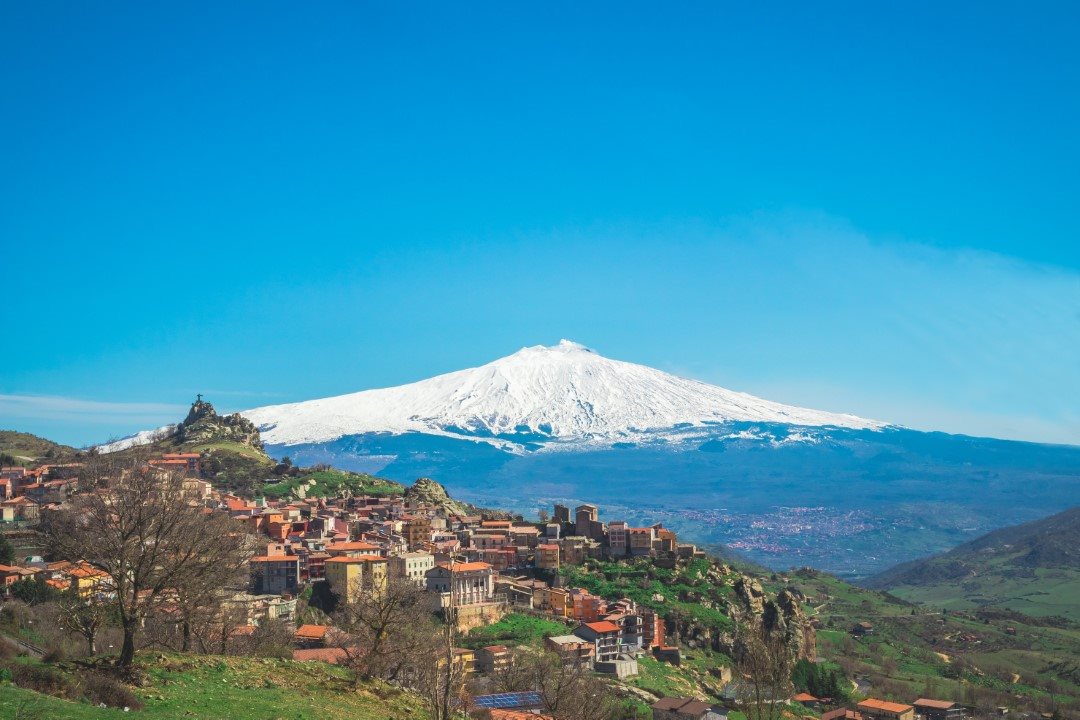 Monte Etna
Monte EtnaBelieved by the ancient Greeks to have been the dwelling place of Cyclops, the fiery Mount Etna is the most significant active volcano in Europe and a UNESCO World Heritage Site located in Parco dell’Etna. Summit its barren, lunar-like craters passing eerie ash fields for a spectacular panoramic view of Sicily. During winter, visitors can ski and toboggan down the mountainside, while in Summer months there’s plenty of hiking trails through lava fields, fertile vineyards, and orchards to explore.
-
 AEOLIAN ISLANDS
AEOLIAN ISLANDSThis pristine volcanic archipelago comprising seven islands; Lipari, Vulcano, Panarea, Salina, Alicudi, Filicudi, and Stromboli provides one the best day trips from Sicily. Travel from the mainland to relax in hot mud baths, hike up volcanic craters in Stromboli, visit medieval villages in Panarea or spend the day sailing, snorkeling, and surfing in the cobalt-blue Tyrrhenian Sea.
-
 Palermo
PalermoAs the capital city of Sicily founded in 734 BC and situated at the southern edge of Europe, Palermo has a dense archeological heritage spanning centuries ranging from the Medieval to Baroque eras. Palazzo dei Normanni, Sicily’s royal palace is a must see as it's one of the best-preserved examples of Arab-Norman-Byzantine architecture in the region. Admire the splendor of its Cappella Palatina chapel with its glittering gold mosaics or visitors can also meander through the city’s famed art museum, Galleria Regionale della Sicilia, to see a diverse collection of medieval artworks.
-
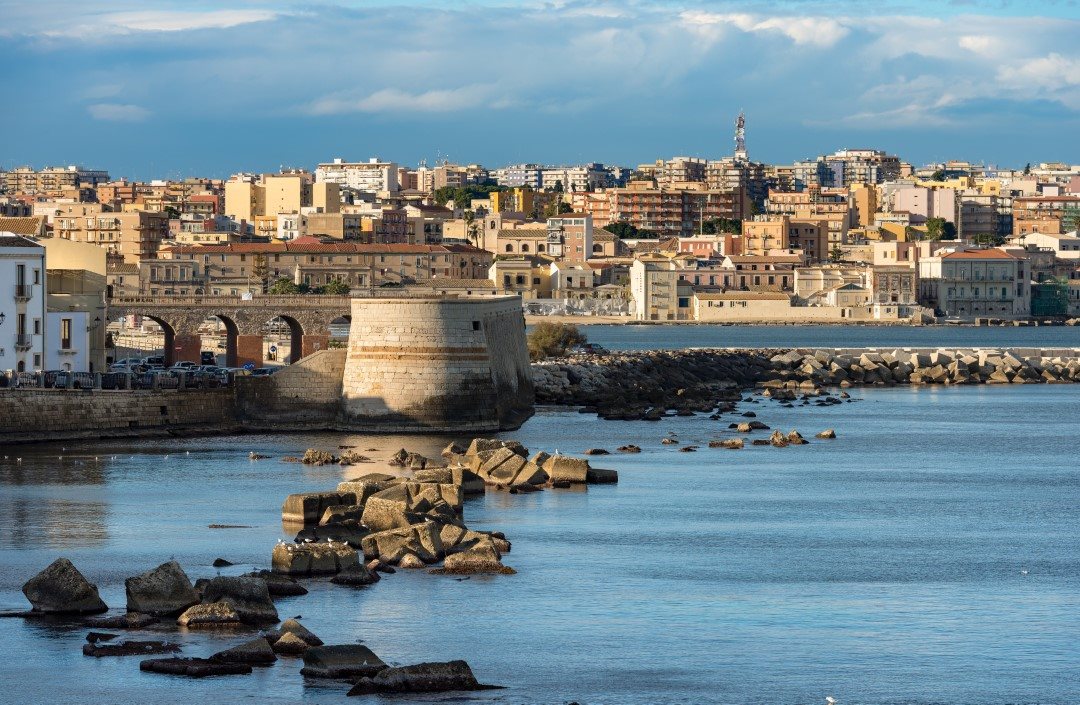 SIRACUSA
SIRACUSATreasured for its Archaeological Park Neapolis, Syracuse is a window into ancient Greek and Roman civilizations, offering one of the best historical 1-day excursions from Sicily. Visitors can see the impressive ruins of this once mighty city in the form of a giant amphitheater, towering castle and many ancient temples. On the island of Ortygia, connected to the mainland by three bridges, resides The Temple of Apollo -, the oldest of its kind in Sicily, dating back to 565 BC.
-
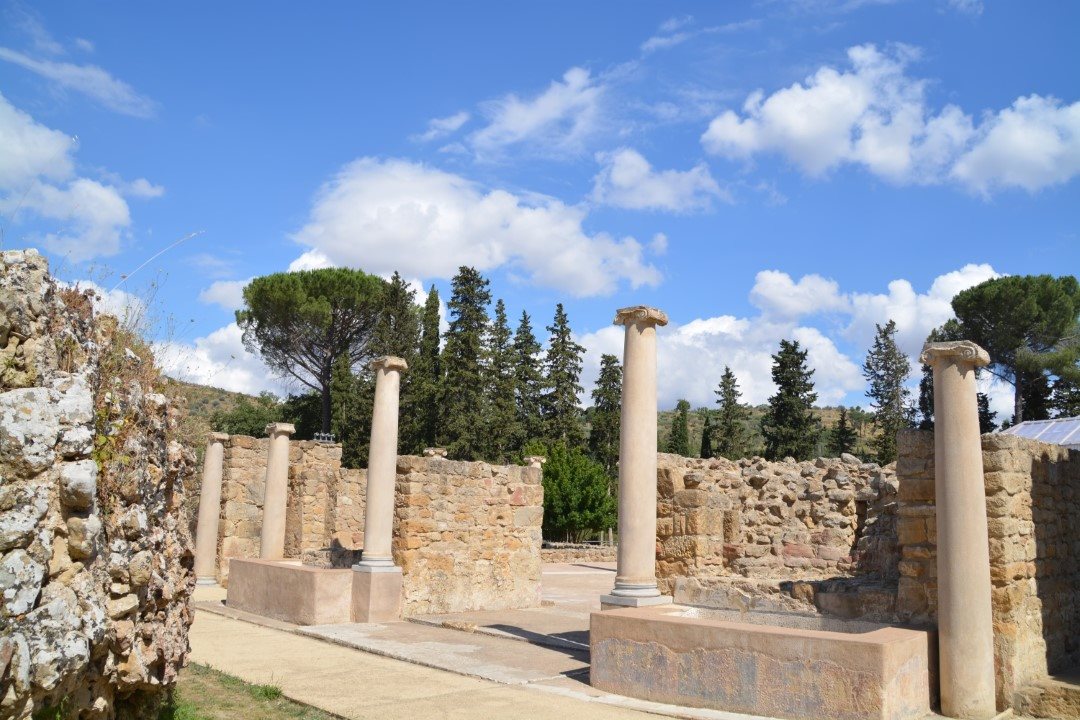 VILLA ROMANA DEL CASALE
VILLA ROMANA DEL CASALETwo miles from the inland town of the Piazza Armerina is the world’s finest collection of multi-colored Roman mosaics housed in Villa Romana del Casale, which was thought to be the retreat of Marcus Aurelius. Spanning over 50 rooms and depicting ancient myths, daily life, and narrative dramas, this must-see UNESCO World Heritage Site has miraculously survived intact since the 4th-century offering fascinating insights into ancient civilization.
-
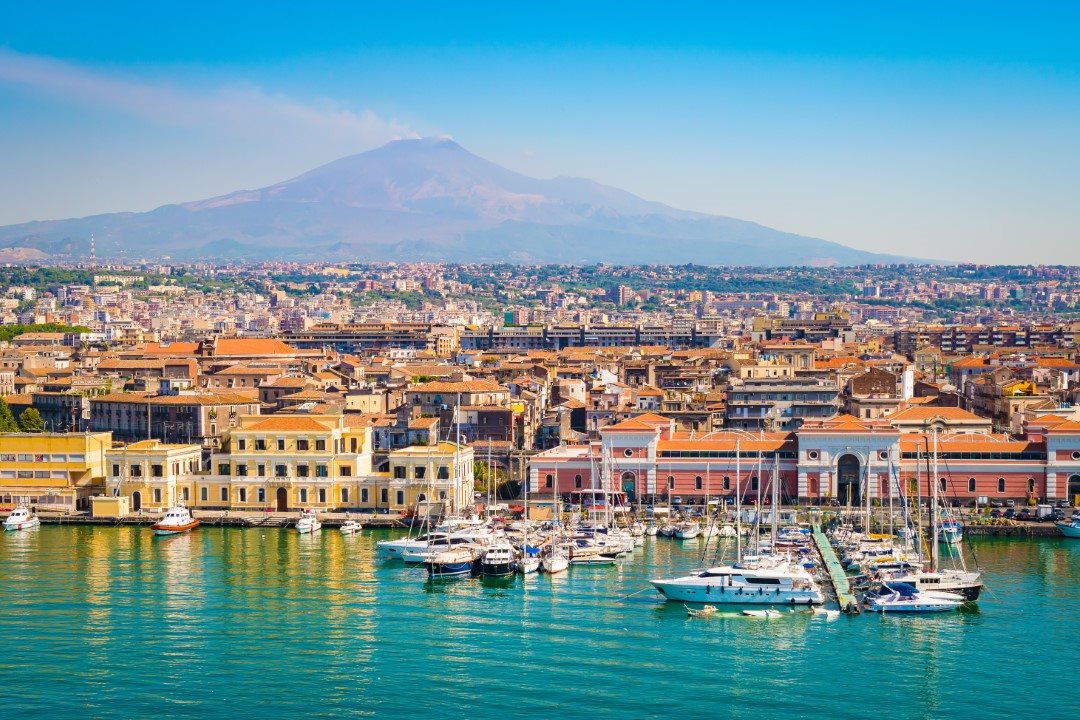 CATANIA
CATANIACatania’s dramatic Baroque architecture sits atop the buildings of past civilizations destroyed by Mount Etna’s eruptions. As Sicily’s second biggest city, it too boasts magnificent architectural sites such as the Basilica Cattedrale Sant’ Agata and the 13th-century Castello Ursino. The city’s central square, Piazza del Duomo, is home to the famous landmark Fontana dell’Elefante, which is made from black lava stone. It’s a good starting point to begin a day exploring the city's rich legacy of museums, parks, and cathedrals.
- At semi-private beaches called “lidos,” visitors are expected to pay a small fee for amenities provided such as chairs, lifeguards, and parasols.
- Sicily’s tap water is drinkable, but it can have a metallic taste in some regions. Those with sensitive stomachs should buy bottled water.
- Selling prices on goods at markets - excluding food - can usually be negotiated down by roughly 10%.
- Nudity is not permitted on beaches in Sicily.
- Always wash hands with water or a sanitizer to get rid of germs.
- Walk around to get a general idea of average prices before buying.
- Always take sandals, some beaches are pebbly which can make walking uncomfortable.
- Use discretion when buying street food, especially dairy products and meat that stand out in the open.
- Always take enough cash to markets
- Only take what you need and leave valuables at your accommodation to avoid petty theft.
- Rinse and peel fresh fruit and vegetables before eating.
- Enquire about opening and closing times before visiting. Not all markets are open seven days a week, and many only operate in the morning.
- Use sunscreen to protect skin against sunburn, especially during hot, summer months.
- Keep hydrated and alternate alcoholic beverages with water.
- Avoid unpasteurized milk and dairy products.
- Markets are busy areas, always keep an eye on valuables to avoid pickpocket theft.
- Apply insect repellent to keep mosquitos at bay.
- It’s considered rude to touch produce or goods with bare hands.
-
-
WHAT TO EAT IN SICILY?
The extraordinary richness of Sicilian cuisine is a result of different civilizations who, through the ages, have contributed different produce and culinary techniques to Sicilian gastronomy for over three millennia. Included by UNESCO in the list of intangible cultural heritage, the Mediterranean diet is influenced by North African, Greek and Arab cuisine. Arabs introduced nutmeg, cloves, oranges and couscous, which is common in dishes in the south and can be traced back to North Africa, while Greeks brought olives and grapes cultivating olive oil and wine production. Later, the Romans introduced chickpeas and some forms of pasta, spurring the island’s grain production. Spices like oregano, mint, fennel, and rosemary are daily seasonings common in many local dishes. Tomatoes are often the base for pasta sauces and soups, while ricotta is an essential ingredient used in pasta and pastries. Olive oil is a typical bread dip, and citrus zest is found in everything from vegetable dishes to desserts. Wondering what to eat in Sicily? With rich and tasty starters like Caponata, to seafood and meat and fish main courses such as Pasta con le Sarde, as well as dessert specialties including Cannoli and Cassata, there’s plenty to choose from when it comes to trying Sicilian cuisine. Here’s a brief guide to the island’s traditional food, as well as some eating tips in Sicily.
-
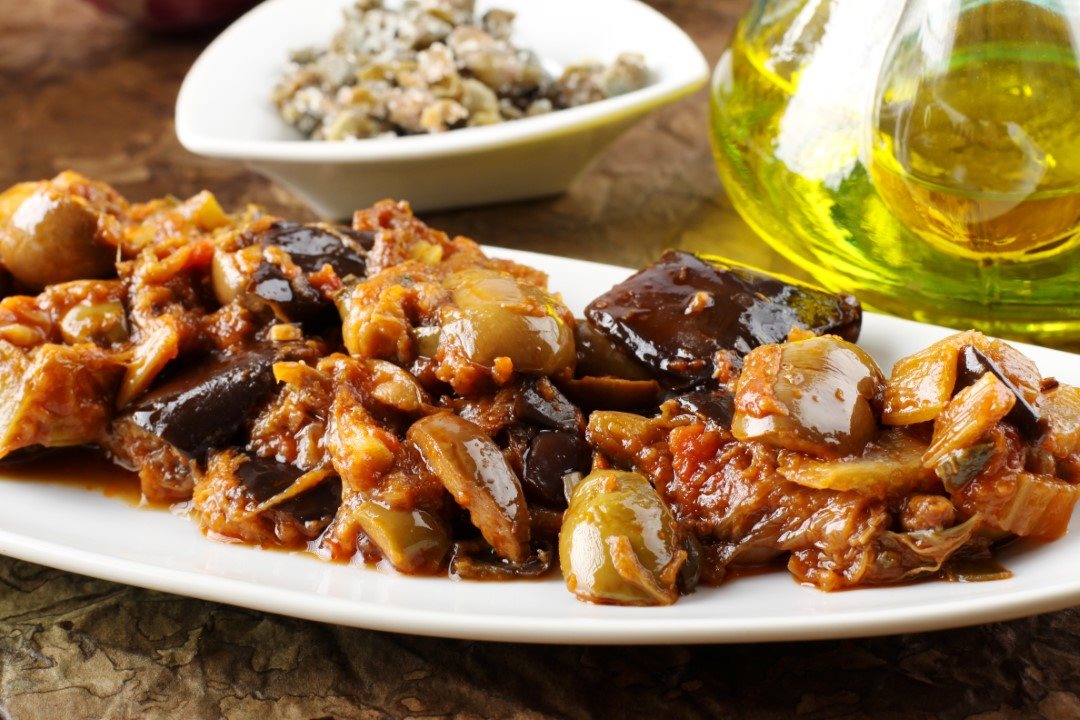 THE BEST TRADITIONAL FOOD FROM SICILY
THE BEST TRADITIONAL FOOD FROM SICILYThe vegetable dish Caponata, consisting of chopped, fried eggplant, celery, sweetened vinegar and capers tossed together in a sweet and sour dish is mostly enjoyed as a starter. To taste the classic Sicilian flavor palette, order Pasta con le Sarde, a main pasta dish with sardines and fennel. Its Arabic combination of sultanas, nuts, and saffron is testament to the island’s rich culinary history. Another classic Sicilian dish is Farsumagru, a traditional roll of steak filled with eggs and minced meats, which dates back to the 13th century. For dessert, there’s ubiquitous Cannoli consisting of tube-shaped shells of fried pastry dough filled with creamy Ricotta or Cassata, a plain white cake filled with sheep’s milk Ricotta, topped with sugared fruits. Sicily prides itself on its delicious street food. When strolling through its towns be sure to try Arancini, a fried rice ball filled with minced meat, green peas or ham, and cheese, as well as Sfincione, which is similar to pizza but has a thicker crust.
-
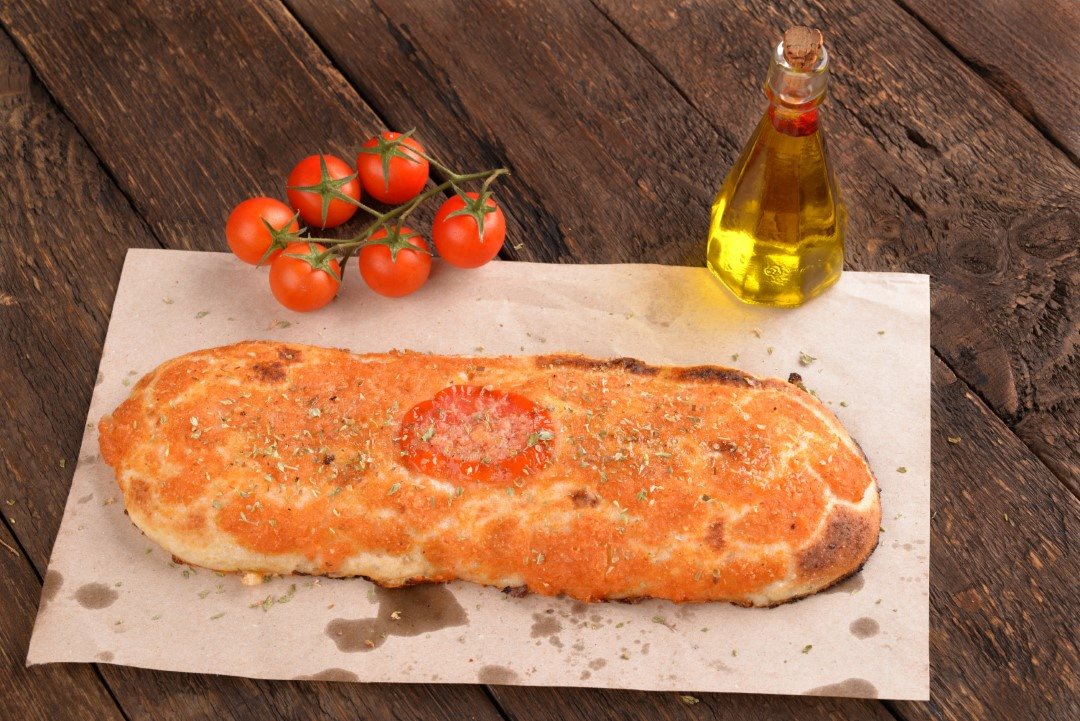 HOW TO MAKE SFINCIONE
HOW TO MAKE SFINCIONEPrepare the dough 12 hours in advance by mixing 500g flour, 1 tsp of salt and 25g of yeast with 250ml of warm water. Preheat oven to 500 degrees and roll out dough. Use a fork to poke holes all over dough to ensure it rises without giant bubbles.Toast ½ a cup of breadcrumbs in a large skillet until golden brown. Add 3 thinly sliced medium onions and cook in olive oil until tender.Turn down heat and stir in 100g of crushed of pine nuts, 1 tbsp red pepper flakes, 100g of raisins and 2 tsp of oregano.Arrange 6 anchovy fillets evenly over the dough and spread 4 tbsp of tomato sauce over the entire crust. Sprinkle the breadcrumb topping over the dough and drizzle with remaining olive oil.Allow the dough to rise before baking in the oven until golden brown.
-
 LIQUORS AND DRINKS YOU MUST TASTE IN SICILY
LIQUORS AND DRINKS YOU MUST TASTE IN SICILYSicily has a long tradition of winemaking of which Malvasia, Grillo and Nero d’Avola wines are it's most renowned. Referred to as “the nectar of the gods,” Malvasia is a fortified sweet wine with a heavy body and soft texture in the mouth. Nero d’ Avola, frequently compared to Syrah, is full-bodied and pairs well with meat, while Grillo is an easy-drinking white wine with fruit notes, enjoyed with poultry and seafood. Liqueurs such as Grappa, Limoncello, and Amaretto are popular digestives enjoyed after meals. Non-alcoholic, lemon and soda water Seltzers, as well as Granita, a semi-frozen dessert drink made from sweet syrup and hand-crushed ice, are perfect for cooling down during hot Sicilian days.
- At semi-private beaches called “lidos,” visitors are expected to pay a small fee for amenities provided such as chairs, lifeguards, and parasols.
- Sicily’s tap water is drinkable, but it can have a metallic taste in some regions. Those with sensitive stomachs should buy bottled water.
- Selling prices on goods at markets - excluding food - can usually be negotiated down by roughly 10%.
- Nudity is not permitted on beaches in Sicily.
- Always wash hands with water or a sanitizer to get rid of germs.
- Walk around to get a general idea of average prices before buying.
- Always take sandals, some beaches are pebbly which can make walking uncomfortable.
- Use discretion when buying street food, especially dairy products and meat that stand out in the open.
- Always take enough cash to markets
- Only take what you need and leave valuables at your accommodation to avoid petty theft.
- Rinse and peel fresh fruit and vegetables before eating.
- Enquire about opening and closing times before visiting. Not all markets are open seven days a week, and many only operate in the morning.
- Use sunscreen to protect skin against sunburn, especially during hot, summer months.
- Keep hydrated and alternate alcoholic beverages with water.
- Avoid unpasteurized milk and dairy products.
- Markets are busy areas, always keep an eye on valuables to avoid pickpocket theft.
- Apply insect repellent to keep mosquitos at bay.
- It’s considered rude to touch produce or goods with bare hands.
-
-
WHAT ARE THE BEST THINGS TO DO IN SICILY?
Sicily dazzles travelers with its profundity of cultural treasures and mesmerizing landscapes ranging from pebbled beaches to ash-covered volcanic craters and rural regions with olive and wine vineyards, offering visitors an inordinate amount of entertaining activities to choose from. Discovering the island's rich history and cultural legacy, visiting the sublime Valley of the Temples, diving into refreshing, turquoise waters, going on wine tours and tastings, heading on sailing and boat trips and exploring its numerous caves are some of the best things to do in Sicily.
-
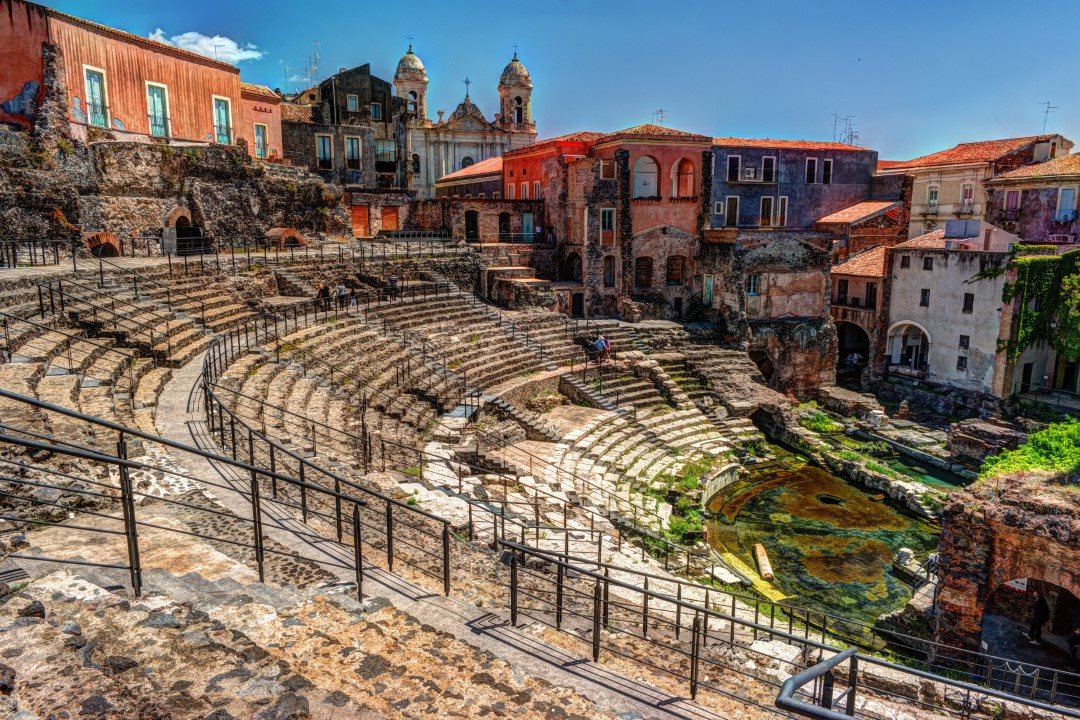 DISCOVER THE HISTORY AND CULTURAL LEGACY
DISCOVER THE HISTORY AND CULTURAL LEGACYWith Sicily’s countless Greek temples, Byzantine castles and Baroque cathedrals, it's best to pick some of the leading attractions and spend time exploring their surrounding areas than trying to see everything at once. Head southeast to the island’s Baroque town of Ragusa, or visit the Medieval town of Erice with its impressive Castello di Venere. Palermo, the capital city with its Teatro Massimo opera house and over 30 remarkable cultural sites, is a must-see. Make time to stroll through its breathtaking streets, snack on its delectable street food and observe Sicilian culture.
-
 VISIT THE VALLEY OF THE TEMPLES
VISIT THE VALLEY OF THE TEMPLESLocated in Southern Sicily on a ridge overlooking Agrigento is the Temple of Concordia, one of the most beautiful examples of Greek Doric architecture which has survived fully intact. The site’s seven temples and agora, pagan and Christian necropolises gives visitors a rough idea of what the mighty Hellenic city was like in its heyday. After visiting these impressive structures, stop by the archeological museum to learn about the region’s history and what role the temples played in ancient Akragas.
-
 DIVE INTO TURQUOISE WATERS
DIVE INTO TURQUOISE WATERSNot all of this Mediterranean island is about history, some of the best activities in Sicily are found along its coast. Snorkel between grottos in the marine reserve Ustica, scuba dive in glittering waters at Syracuse or pick one of Sicily’s favorite golden beaches such as Mondello or San Vito lo Capo with gentle swells to kite-surf, kayak and swim in crystalline seas.
-
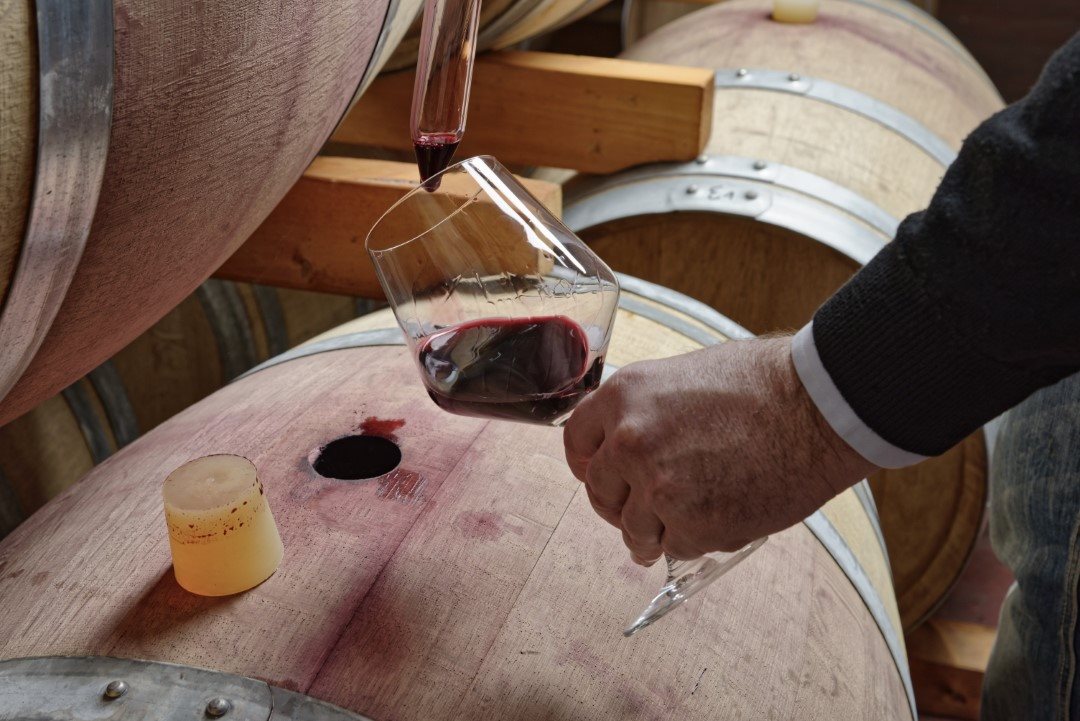 WINE TOURS AND TASTINGS
WINE TOURS AND TASTINGSSicily is one of the most significant viticultural region in Italy. From the fertile foothills of Mount Etna in the east to Trapani in the west and the Aeolian Islands in the north, comes its famous wines Etna Rosso, Marsala and Alcamo Bianco. Plan a trip driving through the countryside to the wine-growing regions of Mount Etna, Vittoria, Nota, and Faro and taste some of the best Sicilian wines on offer.
-
 SAILING AND BOAT TRIPS
SAILING AND BOAT TRIPSYacht chartering or going on a scenic cruise around Sicily’s picturesque coast provides a different view of the island’s majestic sites, such as the Scala dei Turchi. Pick from squid fishing-orientated boat trips to opulent cruises around the Aeolian islands or charter a yacht for a more personalised experience.
-
 EXPLORE THE NUMEROUS CAVES
EXPLORE THE NUMEROUS CAVESFor those interested in active tourism, Sicily’s spectacular caves offer an exciting alternative to its beautiful beaches. Explore Grotta Mangiapane near Trapani where a well-preserved, pre-historic hamlet nestled inside the opening between two mountain peaks resides. Humans first lived in the cave 20,000 years ago and again from the 1800s to the 1950s when it was inhabited by the Mangiapane family, after whom the place is named.
- At semi-private beaches called “lidos,” visitors are expected to pay a small fee for amenities provided such as chairs, lifeguards, and parasols.
- Sicily’s tap water is drinkable, but it can have a metallic taste in some regions. Those with sensitive stomachs should buy bottled water.
- Selling prices on goods at markets - excluding food - can usually be negotiated down by roughly 10%.
- Nudity is not permitted on beaches in Sicily.
- Always wash hands with water or a sanitizer to get rid of germs.
- Walk around to get a general idea of average prices before buying.
- Always take sandals, some beaches are pebbly which can make walking uncomfortable.
- Use discretion when buying street food, especially dairy products and meat that stand out in the open.
- Always take enough cash to markets
- Only take what you need and leave valuables at your accommodation to avoid petty theft.
- Rinse and peel fresh fruit and vegetables before eating.
- Enquire about opening and closing times before visiting. Not all markets are open seven days a week, and many only operate in the morning.
- Use sunscreen to protect skin against sunburn, especially during hot, summer months.
- Keep hydrated and alternate alcoholic beverages with water.
- Avoid unpasteurized milk and dairy products.
- Markets are busy areas, always keep an eye on valuables to avoid pickpocket theft.
- Apply insect repellent to keep mosquitos at bay.
- It’s considered rude to touch produce or goods with bare hands.
-
-
WHAT TO BUY IN SICILY
Found in town squares, hidden behind imposing cathedrals and between Baroque buildings, the variety of smells and noisy atmospheres of Sicily’s markets have a long history dating back to the 9th century. Wondering what to buy in Sicily? While the fresh produce at farmers markets - ranging from catches of the day to mouthwatering cheeses - are highly recommended, there are a few other unique souvenirs visitors can buy as gifts and reminders of their Mediterranean holiday. Traditional Caltagirone ceramics such as pine cones, vases and serving ware, handmade volcanic jewelry from Mount Etna, wood marionettes and candelabras, as well as embroidered textiles, are just a few favorite Sicily souvenirs to look out for.
-
 WHERE TO SHOP IN SICILY
WHERE TO SHOP IN SICILYWhile Palermo’s markets have the most historical clout, each region in Sicily has its own farmers market and souvenir boutiques or flea markets. Catania, Taormina, Ragusa, Caltagirone and Syracuse all have their specialities when it comes to shopping in Sicily.
-
 PALERMO
PALERMOPalermo’s four main markets and their side streets, Ballarò, Il Capo, Borgo Vecchio, and Vucciria are some of the best destinations for shopping in Sicily. Antique-lovers with discerning eyes will enjoy perusing through period jewelry pieces and vintage Italian glassware, while those looking for traditional souvenirs will find finely-made embroidered tablecloths and wooden marionettes.
-
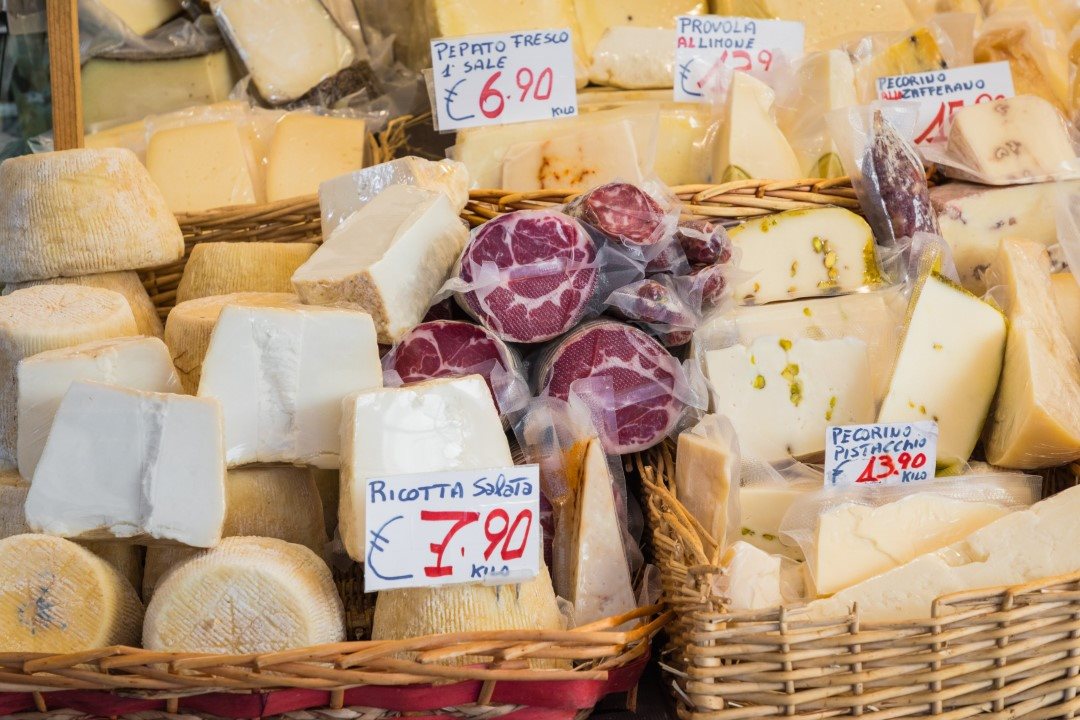 CATANIA
CATANIAAlthough Catania is renowned for La Pescheria, one of Italy’s largest fish markets situated on a UNESCO World Heritage Site, its primary market Fea ‘o Luni, in the baroque Piazza Carlo Alberto, sells a variety of leather goods, elaborately-carved, Baroque-style wooden candelabras and the famous Catania puppets.
-
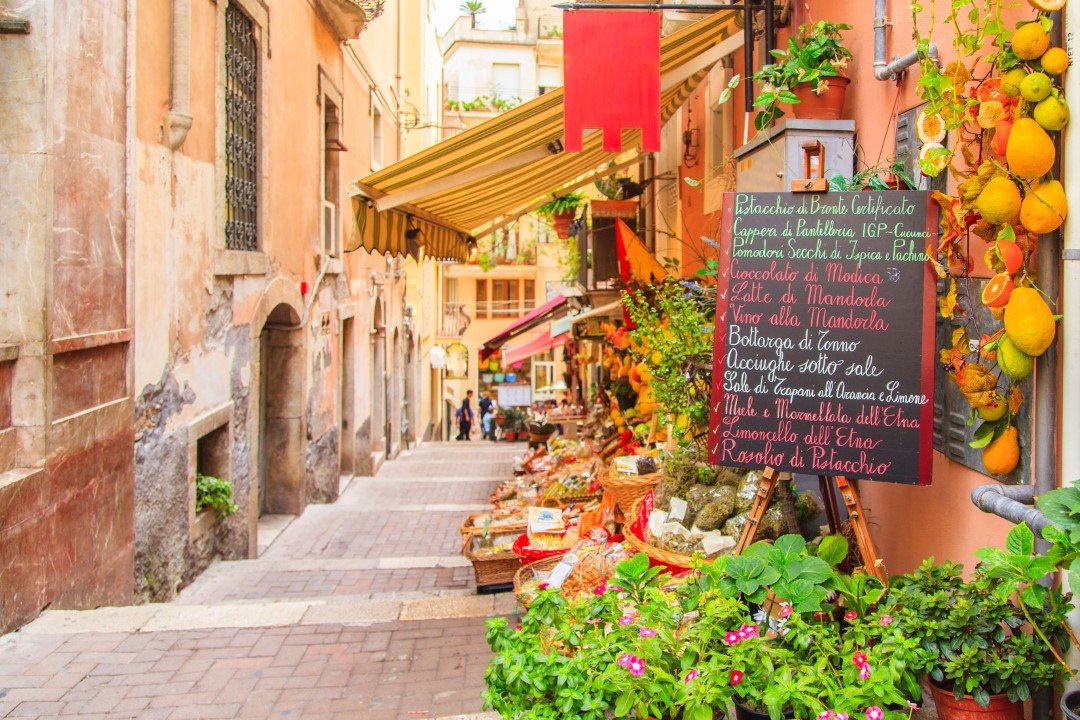 TAORMINA
TAORMINACorso Umberto, the main street of Taormina and the alleyways leading off it have many souvenir boutiques selling typical Sicilian craftwork such as pottery, carved marble, gold-jewelry with semi-precious stones and statues made from lava stone. In summer near the Piazza Carmine, there’s an open-air market where visitors can buy local food products such as marzipan sweet boxes and the vino alle mandorle, a dry white wine made from bitter almonds.
-
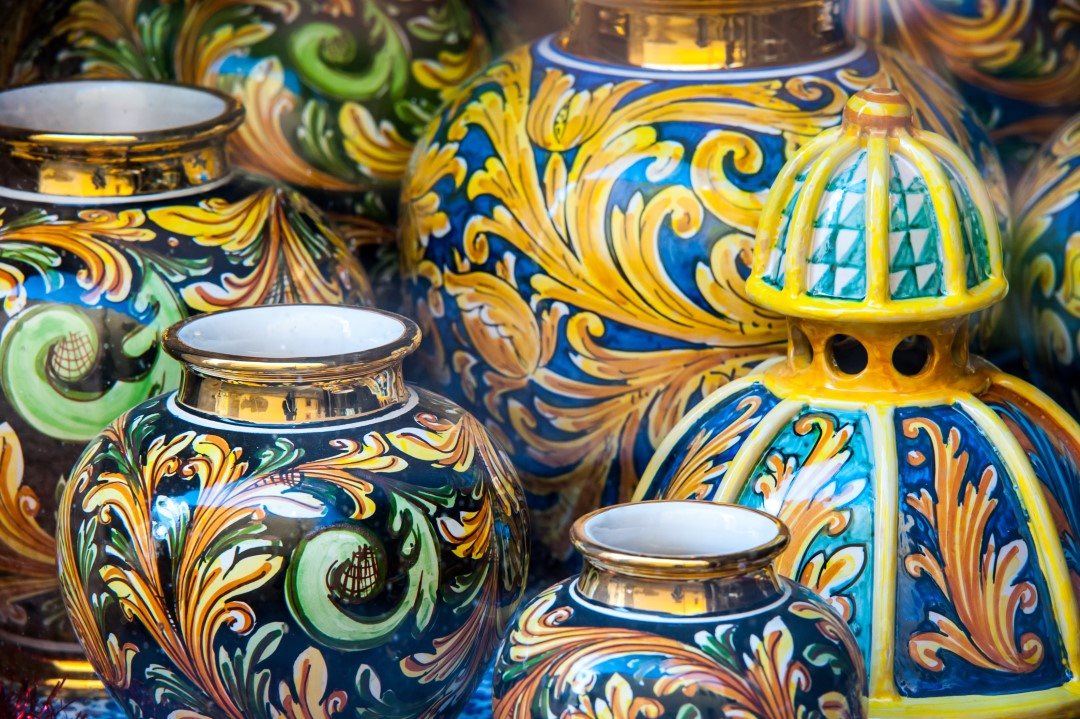 CALTAGIRONE
CALTAGIRONENicknamed the “city of Sicilian ceramics” due to the thousand-year-old craft that’s still practiced in the region today, Caltagirone is the best place in Sicily to buy ceramics. There’s plenty of finely painted vases to smaller items such as serving ware, pine cones (a traditional symbol of hospitality) and decorative tiles for sale, which are hand-painted with intricate curls and suitable for all souvenir budgets.
-
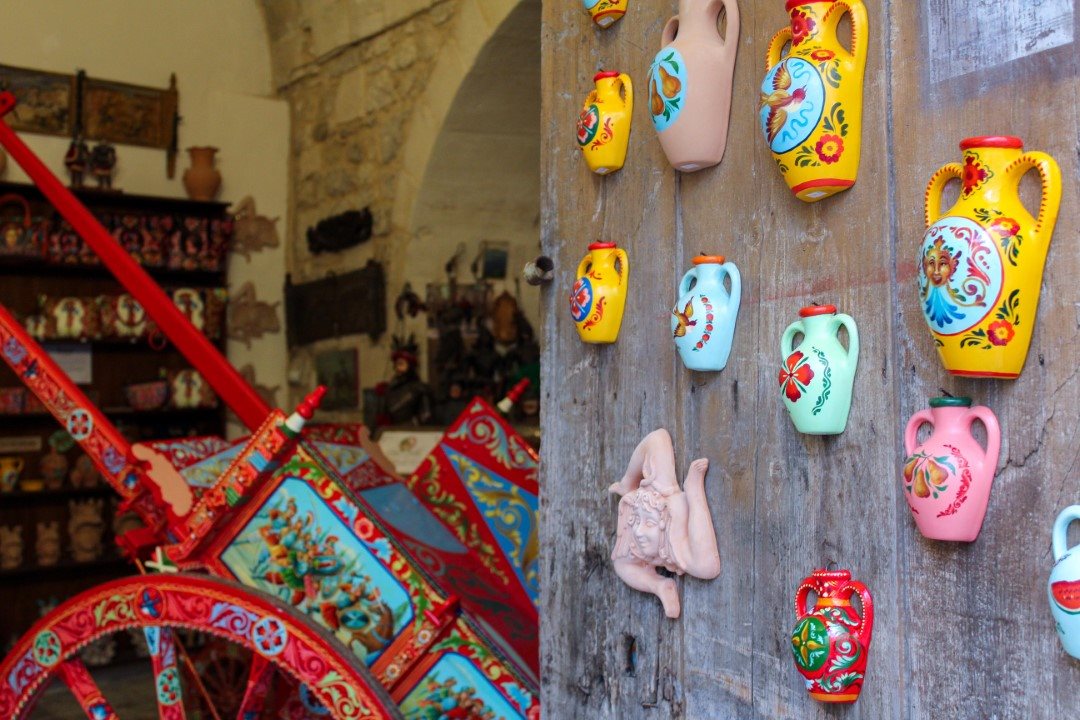 RAGUSA
RAGUSACorso XXV Aprile, the main road in the southern town Ragusa, is an excellent spot to buy Sicily souvenirs, but more importantly, Ragusa is also known for its traditional embroidery techniques called sfilato siciliano, which are found on tablecloths, linens, and towels. Rural farmhouses in the area sometimes sell their handmade textiles to visitors passing by.
- At semi-private beaches called “lidos,” visitors are expected to pay a small fee for amenities provided such as chairs, lifeguards, and parasols.
- Sicily’s tap water is drinkable, but it can have a metallic taste in some regions. Those with sensitive stomachs should buy bottled water.
- Selling prices on goods at markets - excluding food - can usually be negotiated down by roughly 10%.
- Nudity is not permitted on beaches in Sicily.
- Always wash hands with water or a sanitizer to get rid of germs.
- Walk around to get a general idea of average prices before buying.
- Always take sandals, some beaches are pebbly which can make walking uncomfortable.
- Use discretion when buying street food, especially dairy products and meat that stand out in the open.
- Always take enough cash to markets
- Only take what you need and leave valuables at your accommodation to avoid petty theft.
- Rinse and peel fresh fruit and vegetables before eating.
- Enquire about opening and closing times before visiting. Not all markets are open seven days a week, and many only operate in the morning.
- Use sunscreen to protect skin against sunburn, especially during hot, summer months.
- Keep hydrated and alternate alcoholic beverages with water.
- Avoid unpasteurized milk and dairy products.
- Markets are busy areas, always keep an eye on valuables to avoid pickpocket theft.
- Apply insect repellent to keep mosquitos at bay.
- It’s considered rude to touch produce or goods with bare hands.
-

